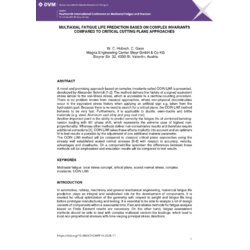- Online only



In automotive, railway, machinery and general mechanical engineering, lifetime prediction with software tools plays an integral and established role for the development of components. It is needed for virtual optimization of the geometry with respect to weight and fatigue life long before prototype manufacturing and testing. It is essential to be able to analyze a lot of geometric variants of components within a reasonable time. Fast and reliable methods for fatigue analysis based on Finite Element results are necessary. On the other hand, fatigue assessment methods should be able to deal with complex multiaxial random-like loadings, which lead to local non-proportional stresses with time-varying principal stress directions.
In this contribution a novel and promising approach…

Datenschutzbedingungen (bearbeiten im Modul "Kundenvorteile")

Lieferbedingungen (bearbeiten im Modul "Kundenvorteile")

Rücksendebedingungen (bearbeiten im Modul "Kundenvorteile")
In automotive, railway, machinery and general mechanical engineering, lifetime prediction with software tools plays an integral and established role for the development of components. It is needed for virtual optimization of the geometry with respect to weight and fatigue life long before prototype manufacturing and testing. It is essential to be able to analyze a lot of geometric variants of components within a reasonable time. Fast and reliable methods for fatigue analysis based on Finite Element results are necessary. On the other hand, fatigue assessment methods should be able to deal with complex multiaxial random-like loadings, which lead to local non-proportional stresses with time-varying principal stress directions.
In this contribution a novel and promising approach based on complex invariants called COIN LiWI is presented, developed by Alexander Schmidt [1-2]. The method delivers the history of a signed equivalent stress similar to the Von-Mises stress, which is accessible to a rainflow-counting procedure. There is no problem known from classical approaches, where non-physical jumps occur in the equivalent stress history when applying an artificial sign e.g. taken from the hydrostatic part. Because there is no need to search for a critical plane, the COIN LiWI method behaves to be very fast. Furthermore, it is applicable to ductile, semi-ductile and brittle materials (e.g. steel, Aluminum cast alloy and grey cast iron).
Another important point is the ability to predict correctly the fatigue life of combined bending-torsion loading with 90° phase shift, which represents the extreme case of highest non-proportionality. Whereas other methods deliver non-conservative results and therefore require additional corrections [3], COIN LiWI takes these effects implicitly into account and an optimum fit to test results is possible by the adjustment of an additional material parameter.
The COIN LiWI method will be compared to classical critical plane approaches using the already well established scaled normal stresses [4-6] with respect to accuracy, velocity, advantages and drawbacks. On several examples from industrial applications the differences between those methods will be emphasized.